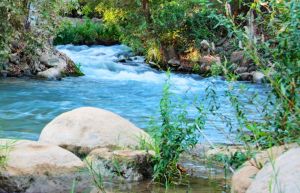 In many religious traditions, the Jordan River has been a holy baptism location for centuries. For Christians, its identity as the place of the baptism of Jesus Christ makes it the original source of all holy water. Pilgrims from all over the world still travel to the shores of the Jordan to perform baptisms. In the last several decades, however, the Jordan has been in the middle of much regional conflict. It has also seen quite a bit of industrial development. As a result, much of this crooked river is either blocked from public access, polluted or both. There is currently a movement among involved countries to restore the Jordan to its prior state, so that it may once again physically embody the symbol of cleansing and renewal it has been for so long to so many.
In many religious traditions, the Jordan River has been a holy baptism location for centuries. For Christians, its identity as the place of the baptism of Jesus Christ makes it the original source of all holy water. Pilgrims from all over the world still travel to the shores of the Jordan to perform baptisms. In the last several decades, however, the Jordan has been in the middle of much regional conflict. It has also seen quite a bit of industrial development. As a result, much of this crooked river is either blocked from public access, polluted or both. There is currently a movement among involved countries to restore the Jordan to its prior state, so that it may once again physically embody the symbol of cleansing and renewal it has been for so long to so many.
Water in the Holy Land
Nearly one million visitors a year flock to the Jordan River to participate in the rite of baptism. This is a practice that has been going on since the fourth century. In addition to baptism, people have looked to the Jordan for healing and strength. Traditionally, people have looked to the waters of the Jordan to imbue protection and purity on those who experience it. People come to immerse themselves in the river, as well as to take the waters back home with them. It may be used in a baptism performed anywhere and by anyone. One cannot wade in just anywhere, however. Today, pilgrims are limited to visiting one of three baptismal location on the river. Since 1967, most of the river has remained inaccessible. The three points of entry are:
- Al Maghtas Baptism Site. Jordanians have been able to use this site north of the Dead Sea since signing a peace treaty with Israel in 1994.
- Qasr al Yehud. Palestinians may access the river in this Israeli-controlled baptismal location on the West Bank.
- Yardenit Baptismal Site, located in Israel.
Pollution: A By-Product of Modern Times
The Jordan River remains unchanged as a symbol of renewal for many religious practices. Physically, it is very changed indeed from the mighty river it once was. Where once there were rapids and cascading waters throughout the river, now there is muddy sediment. Dams, diversion canals and irrigation projects have reduced the river's flow to one tenth of its historic level. In addition, raw sewage and agricultural runoff pollute what remains of the water. The Jordan may be considered to be an endangered ecosystem.
A Center of Conflict
In many ways, it is no surprise that the Jordan River runs through an area of the world that experiences so much conflict. The Middle East is often regarded as the birthplace of many civilizations and religious traditions, and remains deeply important to so many today. Plus, as elsewhere where resources are scarce, water is a critical issue in the Middle East. All of this combines to make the Jordan River a contested watercourse on both geopolitical and economic grounds. Through it all, its spiritual significance remains undiminished for people in the region and worldwide.
Seeking Regional Cooperation
Rehabilitation efforts to restore the Jordan River may happen only through the cooperation of the countries who share its banks. Naturally, residents of all regional nations would benefit from bringing the river back to health. Christian, Jewish and Muslim leaders have a historical and spiritual interest in preserving a location so deeply significant to their religious and cultural traditions. As it was in ancient times, the Jordan may continue to be a meeting point for the diversity of a rich and complex region of the world. The river is both the embodiment of a symbol of boundaries and crossings, as well as a living metaphor for rebirth, spiritual cleansing and salvation.
Add Your Comment